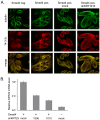Keratin 23, a novel DPC4/Smad4 target gene which binds 14-3-3ε
- PMID: 21492476
- PMCID: PMC3095566
- DOI: 10.1186/1471-2407-11-137
Keratin 23, a novel DPC4/Smad4 target gene which binds 14-3-3ε
Abstract
Background: Inactivating mutations of SMAD4 are frequent in metastatic colorectal carcinomas. In previous analyses, we were able to show that restoration of Smad4 expression in Smad4-deficient SW480 human colon carcinoma cells was adequate to suppress tumorigenicity and invasive potential, whereas in vitro cell growth was not affected. Using this cellular model system, we searched for new Smad4 targets comparing nuclear subproteomes derived from Smad4 re-expressing and Smad4 negative SW480 cells.
Methods: High resolution two-dimensional (2D) gel electrophoresis was applied to identify novel Smad4 targets in the nuclear subproteome of Smad4 re-expressing SW480 cells. The identified candidate protein Keratin 23 was further characterized by tandem affinity purification. Immunoprecipitation, subfractionation and immunolocalization studies in combination with RNAi were used to validate the Keratin 23-14-3-3ε interaction.
Results: We identified keratins 8 and 18, heat shock proteins 60 and 70, plectin 1, as well as 14-3-3ε and γ as novel proteins present in the KRT23-interacting complex. Co-immunoprecipitation and subfractionation analyses as well as immunolocalization studies in our Smad4-SW480 model cells provided further evidence that KRT23 associates with 14-3-3ε and that Smad4 dependent KRT23 up-regulation induces a shift of the 14-3-3ε protein from a nuclear to a cytoplasmic localization.
Conclusion: Based on our findings we propose a new regulatory circuitry involving Smad4 dependent up-regulation of KRT23 (directly or indirectly) which in turn modulates the interaction between KRT23 and 14-3-3ε leading to a cytoplasmic sequestration of 14-3-3ε. This cytoplasmic KRT23-14-3-3 interaction may alter the functional status of the well described 14-3-3 scaffold protein, known to regulate key cellular processes, such as signal transduction, cell cycle control, and apoptosis and may thus be a previously unappreciated facet of the Smad4 tumor suppressive circuitry.
Figures




Similar articles
-
Keratin23 (KRT23) knockdown decreases proliferation and affects the DNA damage response of colon cancer cells.PLoS One. 2013 Sep 9;8(9):e73593. doi: 10.1371/journal.pone.0073593. eCollection 2013. PLoS One. 2013. PMID: 24039993 Free PMC article.
-
Keratin 23 promotes telomerase reverse transcriptase expression and human colorectal cancer growth.Cell Death Dis. 2017 Jul 27;8(7):e2961. doi: 10.1038/cddis.2017.339. Cell Death Dis. 2017. PMID: 28749462 Free PMC article.
-
Differential proteome analysis of colon carcinoma cell line SW480 after reconstitution of the tumour suppressor Smad4.Anal Bioanal Chem. 2006 Nov;386(6):1603-12. doi: 10.1007/s00216-006-0803-9. Epub 2006 Oct 17. Anal Bioanal Chem. 2006. PMID: 17043799
-
Interactions between extracellular signal-regulated protein kinase 1, 14-3-3epsilon, and heat shock factor 1 during stress.J Biol Chem. 2004 Nov 19;279(47):49460-9. doi: 10.1074/jbc.M406059200. Epub 2004 Sep 10. J Biol Chem. 2004. PMID: 15364926
-
Smad4/DPC4.J Clin Pathol. 2018 Aug;71(8):661-664. doi: 10.1136/jclinpath-2018-205095. Epub 2018 May 2. J Clin Pathol. 2018. PMID: 29720405 Review.
Cited by
-
Modulation of protein fate decision by small molecules: targeting molecular chaperone machinery.Acta Pharm Sin B. 2020 Oct;10(10):1904-1925. doi: 10.1016/j.apsb.2020.01.018. Epub 2020 Feb 7. Acta Pharm Sin B. 2020. PMID: 33163343 Free PMC article. Review.
-
MAL overexpression leads to disturbed expression of genes that influence cytoskeletal organization and differentiation of Schwann cells.ASN Neuro. 2014 Sep 10;6(5):1759091414548916. doi: 10.1177/1759091414548916. Print 2014. ASN Neuro. 2014. PMID: 25290060 Free PMC article.
-
Keratin 79 is a PPARA target that is highly expressed by liver damage.Biochem Biophys Res Commun. 2023 Apr 2;650:132-136. doi: 10.1016/j.bbrc.2023.01.071. Epub 2023 Jan 30. Biochem Biophys Res Commun. 2023. PMID: 36796223 Free PMC article.
-
The combination of SMAD4 expression and histological grade of dysplasia is a better predictor for the malignant transformation of oral leukoplakia.PLoS One. 2013 Jun 24;8(6):e66794. doi: 10.1371/journal.pone.0066794. Print 2013. PLoS One. 2013. PMID: 23826135 Free PMC article.
-
Multiple roles for keratin intermediate filaments in the regulation of epithelial barrier function and apico-basal polarity.Tissue Barriers. 2016 May 2;4(3):e1178368. doi: 10.1080/21688370.2016.1178368. eCollection 2016 Jul-Sep. Tissue Barriers. 2016. PMID: 27583190 Free PMC article. Review.
References
Publication types
MeSH terms
Substances
LinkOut - more resources
Full Text Sources
Other Literature Sources
Miscellaneous

